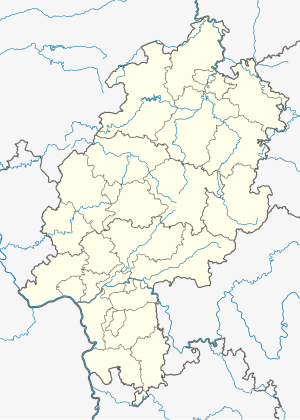Willinger Viaduct
Coordinates: 51 ° 17 ′ 24 ″ N , 8 ° 37 ′ 3 ″ E
| Willinger Viaduct | ||
|---|---|---|
| The Willinger Viaduct of the Uplandbahn | ||
| Official name | Itter Bridge | |
| Convicted | Uplandbahn | |
| Subjugated | Itter , Bundesstrasse 251 | |
| place | Willingen (Upland) -Willingen, Northern Hesse | |
| construction | Arch bridge made of natural stone and poured concrete | |
| overall length | 294 m | |
| Number of openings | 11 | |
| Longest span | 25 m | |
| height | 31 m | |
| start of building | 1914 | |
| completion | 1917 | |
| opening | April 2, 1917 | |
| closure | 1999-2003 | |
| location | ||
|
|
||
| Above sea level | 580 m above sea level NHN | |
The Willinger Viadukt (officially: Itterbrücke ) is an eleven-arched, 294 m long and 31 m high railway bridge of the Uplandbahn (from Brilon Stadt via Brilon Wald to Korbach ) in Willingen, the core of the municipality of Willingen (Upland) in the North Hessian district of Waldeck-Frankenberg ( Germany ).
Geographical location
The viaduct, at kilometer 61.4 of the Uplandbahn, spans the valley of the Diemel tributary Itter and the federal road 251 southwest of the Orenberg (702 m) at the south-eastern entrance to Willingen.
Bridge data
The single-lane viaduct is 294 m long and 31 m high. It is an arch bridge made of natural stone and poured concrete with eleven bridge arches with a span of 25 m each , resulting in ten bridge piers and two abutments .
history
The viaduct was built from 1914 to 1917 by the Royal Prussian State Railroad through the Cassel Railway Directorate as part of the Wabern-Brilon-Wald railway line, which was completed on April 2, 1917 with the opening of the viaduct and thus the Usseln-Willingen section (in the Korbach - Brilon Wald section Uplandbahn ) built for the transport of people and goods. It is still used today for rail traffic on the Uplandbahn.
In November 1999, traffic on the railway line had to be temporarily suspended due to defects in the Willingen Viaduct (and the viaducts in Usseln , Rhena and Bömighausen ). Since the load-bearing outer shell of the bridge had become dilapidated due to the weather, the structural safety of the structure was at risk. As a result, an engineering office in Kassel developed a new type of renovation principle. The pillars, the interior of which consisted of poured concrete of different quality and strength, were provided with numerous holes 80 mm in diameter up to the foundations and the arches with holes 30 mm in diameter, and these holes were then filled with a cement suspension , which was after Hardening provided new strength. The outer facade was cleaned with water pressure of 2000 bar , loose rock was removed, and then a new outer shell was created with shotcrete . The superstructure of the viaduct was also completely renewed, replacing the sleepers from 1916 and the rails from 1960.
The Usselner Viaduct was renovated in 2002 using this method and the smaller viaducts at Rhena and Bömighausen were completely renovated in 2003 in the same way. After this extensive renovation work, the line could be resumed in December 2003. For the renovation of the Willingen Viaduct alone, 9 million euros were raised.
The viaduct is a cultural monument due to the Hessian Monument Protection Act .
literature
- Heinz Schomann : Railway in Hessen . Railway history and building types 1839–1999 / Railway buildings and lines 1839–1939. In: State Office for Monument Preservation Hessen (Ed.): Cultural monuments in Hessen. Monument topography Federal Republic of Germany . Three volumes in a slipcase. tape 2.2 . Theiss Verlag, Stuttgart 2005, ISBN 3-8062-1917-6 , p. 995 .
Footnotes
- ↑ Schomann: Eisenbahn in Hessen , p. 995.
- ↑ Korbach — Willingen reopened (Hessen Schiene, No. 55, March-May 2004, pp. 7-8)
- ↑ Reopening of the Korbach - Willingen railway line , accessed on October 18, 2019
- ↑ Schomann: Eisenbahn in Hessen , p. 995.


